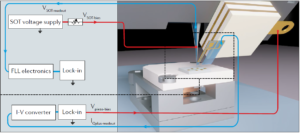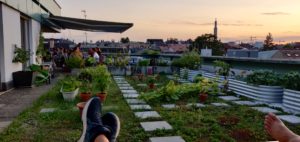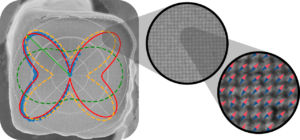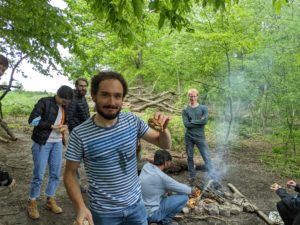2021 News
December 2021
Group Year-end Dinner
On the evening of Friday the 3rd, the group go together along with some alumni for its annual end-of-the-year dinner. This year we celebrated with burgers and drinks at Valentino’s Place in Klein Basel. Thanks to all for a good time and to Dr. Boris Groß for suggesting the venue and organizing.
Article on Janus Particles Published
On the 3rd, Applied Physics Letters published our article entitled, Magnetic hysteresis of individual Janus particles with hemispherical exchange bias caps as a ‘Featured’ article. Janus particles are nano- or micron-sized particles with two sides, each having different physical or chemical properties. Magnetic Janus particles are a particularly interesting subset of these, because their translational and rotational motion can be controlled using externally applied magnetic fields. They can be used for applications ranging from acting as stirrers in lab-on-chip devices, transporters of biological cargo, or biosensors. Crucially, however, magnetic control depends on the particles being magnetized, i.e. they must have a remanent net magnetic moment. This is often not the case, especially in nano- or micron-sized objects.
In our work, we use torque magnetometry to measure the magnetic state of individual Janus particles. We find that although small ferromagnetic Janus particles have a vanishing remanent magnetic moment, we can engineer them to have a robust remanent moment by the addition of an additional antiferromagnetic layer. This promising result means that potentially useful nano- and micron-size magnetic Janus particles can indeed be mass produced.
The work represents a collaboration between our group and the group of Prof. Arno Ehresmann from the University of Kassel in Germany. Ph.D. student Simon Philipp and research scientist Dr. Boris Groß led the project and carried out the measurements and analysis. Mathias Claus, who is now a Ph.D. student in our group, and Marc Sulliger carried out initial measurements during their time as Masters students. Ph.D. students Meike Reginka and Maximillian Merkel from the Ehresmann group fabricated and characterized the samples.
November 2021
Group Kart Outing
 On the afternoon of Thursday the 25th, the group took some time for leisure and fun. 16 of us piled into a van and 2 cars to go karting at the Sundgau karting track, just across the border in France. Despite the fog and chilly weather, everyone went out for 2 or 3 sessions of throwing the gas-powered karts around the track as fast as possible, including the occasional crash and even a track ban. Unfortunately, in our excitement, we managed to forget Mathias Claus at the Department! We’ll make it up to you Mathias. Thanks to all for a good time! Photos here.
On the afternoon of Thursday the 25th, the group took some time for leisure and fun. 16 of us piled into a van and 2 cars to go karting at the Sundgau karting track, just across the border in France. Despite the fog and chilly weather, everyone went out for 2 or 3 sessions of throwing the gas-powered karts around the track as fast as possible, including the occasional crash and even a track ban. Unfortunately, in our excitement, we managed to forget Mathias Claus at the Department! We’ll make it up to you Mathias. Thanks to all for a good time! Photos here.
Thibaud Ruelle Graduates
On Tuesday the 23rd, Ph.D. student Thibaud Ruelle defended his thesis, entitled “Towards Hybrid Optomechanics in a Fiber-Based Fabry-Perot Cavity”, earning his doctorate in Physics summa cum laude. Richard Warburton chaired the exam with Prof. Poggio and Prof. Albert Schliesser (Copenhagen), who joined via teleconference, making up the committee.
Thibaud joined the lab as a Ph.D. student in January 2016 to work with Dr. Floris Braakman on his Ambizione research project on realizing an optomechancial tripartite system. In the meantime, he has built-up a state-of-the-art optomechanical setup and carried out first experiments on it. Congratulations to Dr. Ruelle!
1st NCCR SPIN Site Visit
From the 11th to the 12th, the Department hosted the first Site Visit of the NCCR SPIN. Experts from around the world listened to presentations and discussed posters with members of the consortium. On the 11th, Prof. Poggio gave a talk in the morning and Ph.D. student Luca Forrer presented a poster in the afternoon. The National Center of Competence in Research (NCCR) SPIN is based at the University of Basel with the objective of developing reliable, fast, compact, scalable spin qubits in silicon. Within the consortium, our group focuses on developing electron spin qubit devices.
October 2021
Group at Workshop in Lausanne
From the Wednesday the 27th to Friday the 29th, a number of group members attended the “Computational materials discovery of unconventional magnets” workshop at EPFL in Lausanne, Switzerland. The workshop focused on unconventional magnetism and specifically on understanding, predicting, and realizing of quantum magnetic phases in real materials. Topics covered included quantum spin liquids, materials hosting skyrmion and non-colinear magnetic phases, and 2D magnets. Dr. Kousik Bagani, Dr. Estefani Marchiori, Dr. Floris Braakman, Hinrich Mattiat, Andriani Vervelaki, Daniel Jetter, and Matthias Claus attended from our group. Giulio Romagnoli also attended giving a contributed talk on the 29th entitled, “Real-space imaging of magnetic phases in Cu2OSeO3 crystal”. A program can be found here.
1st Annual FIBsuperProbes Meeting
From the 4th to the 5th, our group hosted the first annual meeting of the FET-Open collaboration led by our group and entitled, “Focused Ion Beam fabrication of superconducting scanning Probes (FIBsuperProbes)“. This collaboration aims to enable a new era in scanning probe microscopy, in which nanometer-scale sensing devices – specifically superconducting devices – can be directly patterned on-tip and used to reveal new types of contrast. The principal investigators involved in the collaboration are Dr. Armin Knoll (IBM Zürich), Prof. José María De Teresa (Zaragoza), and Prof. Dieter Kölle (Tübingen). The meeting included a program of talks, a dinner, and plenty of time for discussion. Special thanks to Kousik Bagani and Claudia Wirth for helping with the organization. A full program can be found here.
Technical Review Published
 On the 1st, Nature Reviews Physics published our paper entitled, Nanoscale magnetic field imaging for 2D materials. The article is a “Technical Review” covering sensitive magnetic scanning probe microscopies and their application to 2D materials. The review discusses how using these techniques to image the recently discovered correlated states hosted in 2D materials will provide crucial local information on quantum phases, including on the spatial variation of order parameters, the presence of domains, and the role of defects. It also addresses the importance of choosing the appropriate probe for the physical system under investigation: the different scaling of magnetization and current contrast with probe-sample spacing and the different physical quantities that are measured by each probe make certain techniques more amenable to certain systems. A link to a view-only PDF is here.
On the 1st, Nature Reviews Physics published our paper entitled, Nanoscale magnetic field imaging for 2D materials. The article is a “Technical Review” covering sensitive magnetic scanning probe microscopies and their application to 2D materials. The review discusses how using these techniques to image the recently discovered correlated states hosted in 2D materials will provide crucial local information on quantum phases, including on the spatial variation of order parameters, the presence of domains, and the role of defects. It also addresses the importance of choosing the appropriate probe for the physical system under investigation: the different scaling of magnetization and current contrast with probe-sample spacing and the different physical quantities that are measured by each probe make certain techniques more amenable to certain systems. A link to a view-only PDF is here.
The paper was a collaboration between Prof. Poggio, post-doc Dr. Estefani Marchiori, former Ph.D. students and post-docs Dr. Lorenzo Ceccarelli and Dr. Nicola Rossi, and collaborators at ETH Zürich: Dr. Luca Lorenzelli and Prof. Christian Degen.
September 2021
New Ph.D. Student Starts
On the 1st, Liza Žaper started as Ph.D. student in the group. Liza completed her Bachelor of Science in 2014 at the University of Zagreb, Croatia and her Masters degree in 2017 at the Polytechnic University of Milan. Before joining our group she worked at the ETH in Zürich. Welcome Liza!
August 2021
First NCCR SPIN Meeting
From the Monday the 30th to Wednesday the 1st, group members attended the first annual meeting of the NCCR SPIN. The National Center of Competence in Research (NCCR) SPIN is based at the University of Basel. Its main objective is to develop reliable, fast, compact, scalable spin qubits in silicon. The Swiss-wide consortium consists of researchers from the University of Basel, IBM Research Europe, ETH Zürich, and EPF Lausanne. Our group is one of the member groups, working on electron spin qubit devices.
The first annual meeting took place in Pontresina, Switzerland. Ph.D. students Luca Forrer, Daniel Jetter, Andriani Vervelaki, Mathias Claus, and Liza Zaper attended the meeting. Liza will be starting as a new Ph.D. student in the group in September. Senior scientist, Dr. Floris Braakman and Prof. Poggio were also in attendance. Luca gave a talk at the meeting entitled, Scanning Nanowire Quantum Dot. A schedule of talks can be found here.
Basel Optomechanics Workshop
On Friday the 27th, our group organized a workshop within the Department of Physics on the topic of ‘Optomechanics’. A number of groups in the Department have been doing work in this field and the workshop provided an opportunty for Ph.D. students, post-doctoral researchers, and PIs to share results, techniques, and exchange new ideas. The workshop took place in the Department’s former cafeteria and included plenty of time for open discussion. Participating groups included the Bruder group, the Maletinsky group, the Treutlein group, the Warburton group, and the Zardo group. Thanks to all for your contributions! A program can be found here.
Machine Shop / Poggio Lab BBQ
 On the 20th, we had our annual barbecue on the department’s roof-top with our colleagues from the Machine Shop, technicians, administrative staff, and friends. The BBQ was a nice opportunity to enjoy the department’s new roof-top garden. It was especially nice to see several group alumni, including Dr. Dennis Weber, Dr. Davide Caddedu, Dr. Denis Vasyukov, and Dr. Lorenzo Ceccarelli, as well as our former administrator, Audrey Fischer. Thanks to all who helped with the organization and see you next year! Pictures are here.
On the 20th, we had our annual barbecue on the department’s roof-top with our colleagues from the Machine Shop, technicians, administrative staff, and friends. The BBQ was a nice opportunity to enjoy the department’s new roof-top garden. It was especially nice to see several group alumni, including Dr. Dennis Weber, Dr. Davide Caddedu, Dr. Denis Vasyukov, and Dr. Lorenzo Ceccarelli, as well as our former administrator, Audrey Fischer. Thanks to all who helped with the organization and see you next year! Pictures are here.
Visitors from Kassel
From the 11th to the 13th, Ph.D. students Meike Reginka and Max Merkel from the University of Kassel visited our group. Both work in the group of Prof. Dr. Arno Ehresmann in the Department of Physics. The have been collaborating with Dr. Boris Groß and Ph.D. student Simon Philipp on an experimental project. On the 11th, the group heard talks about Meike and Max’s research and on the 12th, members of our two groups attended an online meeting to familiarize ourselves with our respective research projects. Thanks to Boris for organizing the visit.
July 2021
PNAS Paper Published
On the 24th, Proceedings of the National Academy of Sciences of the U.S.A. published a paper on twisted bilayer graphene near the second magic angle, to which our group contributed. The manuscript is entitled, Multiple flat bands and topological Hofstadter butterfly in twisted bilayer graphene close to the second magic angle. The work discusses measurements of multiple flat bands in high-quality twisted bilayer graphene close to the theoretically predicted second magic angle. These well-isolated flat moiré bands host a nontrivial topology, which is evidenced by a connecting multiband Hofstadter butterfly spectrum. The manuscript provides a perspective for understanding the emergent quantum phases in twisted bilayer graphene and the fractal Hofstadter spectra of multiple topological bands.
Ph.D. student Giulio Romagnoli carried out transport measurements on twisted bilayer graphene here in Basel at 300 mK with first author Dr. Xiaobo Lu, who was affiliated with ICFO Barcelona at the time. The project was led by Prof. Dmitri Efetov of ICFO.
Lorenzo’s Farewell BBQ at the Birsköpfli
 On the 3rd, group members met up for a farewell BBQ for Lorenzo Ceccarelli, who will soon start a job at Nanosurf in Liestal. The party also marked the 5th annual BBQ at the Birsköpfli park along the river. Although the weather and river did not fully cooperate, we had a relaxing time eating, drinking, and playing in the park. Thanks to all for a good time. Pictures are here. Lorenzo will have his last day in the group on the 9th. Thanks for everything, Lorenzo, and good luck in the new job!
On the 3rd, group members met up for a farewell BBQ for Lorenzo Ceccarelli, who will soon start a job at Nanosurf in Liestal. The party also marked the 5th annual BBQ at the Birsköpfli park along the river. Although the weather and river did not fully cooperate, we had a relaxing time eating, drinking, and playing in the park. Thanks to all for a good time. Pictures are here. Lorenzo will have his last day in the group on the 9th. Thanks for everything, Lorenzo, and good luck in the new job!
June 2021
Interview in EPS Newsletter
This month, an interview of Prof. Poggio appeared in the newsletter of the the Condensed Matter Division (CMD) of the European Physical Society (EPS). See here.
Marcus Moves to Nano Imaging Lab
Post-doctoral researcher and former Ph.D., Dr. Marcus Wyss, is taking a new job as an electron microscopy technician and researcher at the Nano Imaging Lab of the Swiss Nanoscience Institute. He will move just down the street to the Pharmazentrum and will be in charge of the SEM/FIB and TEMs. He will continue to collaborate with our group, especially on the FIBsuperProbes project. We wish you luck on the new position, Marcus, and look forward to continue working together!
May 2021
April 2021
Talk at Virtual MRS Meeting on Néel-type Skyrmions
On the 21st, Prof. Poggio gave a talk entitled, “Stability of Néel-type skyrmion lattice against oblique magnetic fields in GaV4S8 and GaV4Se8” at the 2021 Virtual MRS Spring Meeting. The talk was part of session NM04.01: Magnetic Skyrmions and Topological Effects in Materials and Nanostructures I. The talk focused on our recent measurements of the stability of the skyrmion lattice phase as a function of magnetic field angle and magnitude in Néel-type skyrmion hosts.
Former Master Student Begins Ph.D.
Ph.D student Mathias Claus started in our group in the middle of this month. Mathias did his Master thesis in our group on designing and fabricating nanometer-scale torsional resonators for torque magnetometry. He completed his Bachelor of Science in Nanoscience in 2020 and his and Masters of Science in Nanoscience in 2021, both here at the University of Basel. He will start in the group as a joint member of our group and the group of Prof. Ilaria Zardo.
March 2021
Group Walk and BBQ
 On Wednesday the 24th, group members took advantage of the weather to walk up to the Hornfelsen overlook, just outside of Basel. There, we had a BBQ and enjoyed the sun. Afterwards, some group members kept walking up to St. Chrischona, and then back to the Department via Riehen and Lange Erlen. Thanks to all for a relaxing time. Pictures and movies are here.
On Wednesday the 24th, group members took advantage of the weather to walk up to the Hornfelsen overlook, just outside of Basel. There, we had a BBQ and enjoyed the sun. Afterwards, some group members kept walking up to St. Chrischona, and then back to the Department via Riehen and Lange Erlen. Thanks to all for a relaxing time. Pictures and movies are here.
Nadine Appears in QSIT Video
Ph.D. student Nadine Leisgang of the Warburton Group appeared in a video put out by the NCCR QSIT on women in physics. Nadine has been working closely with our group, in particular with Ph.D. students Hinrich Mattiat and Lukas Schneider, on magnetic scanning probe experiments on 2D materials. See the video here.
New Ph.D. Student Starts
Ph.D student Luca Forrer started in our group this month. Luca completed his Bachelor of Science in Nanoscience in 2019 and his and Masters of Science in Nanoscience in 2020, both here at the University of Basel. He will join our group as part of a joint project with the group of Prof. Dominik Zumbühl funded by the Swiss Nanoscience Institute.
February 2021
Physics Today Webinar
On the 11th at 17:00 CET, Prof. Poggio gave a webinar on the Physics Today platform on the physics underlying magnetic imaging techniques, including MFM, scanning SQUID microscopy, and scanning NV-center microscopy. Dr. Jelena Trbovic of Zurich Instruments discussed how lock-in amplifiers can be used to enhance their sensitivity and contrast of such local measurements. See the webinar here.
January 2021
New Ph.D. Student Starts
On the 15th, Daniel Jetter officially joined our group as a Ph.D. student. Daniel has been working in our group since January 2020, when he started as a visiting Masters student, under the external supervision of Prof. Reinhold Kleiner at the University of Tübingen. He worked on the development of a nanometer-scale SQUID-on-cantilever probe for sensitive magnetic imaging. Daniel finished his Masters in earlier this month.
Physics Today Webinar
On February 11th at 17:00 CET, Prof. Poggio will give a webinar on the Physics Today platform on the physics underlying magnetic imaging techniques, including MFM, scanning SQUID microscopy, and scanning NV-center microscopy. He will discuss how to best apply these techniques to shed light on magnetization patterns, spin configurations, and current distributions in a number of exciting condensed matter systems. Dr. Jelena Trbovic of Zurich Instruments will also discuss how lock-in amplifiers can be used with such local probing techniques to enhance their sensitivity and contrast. Register here.
Paper on Magnetic Mesocrystals Out in PRB
 On the 4th, Physical Review B published our paper entitled, Magnetic anisotropy of individual maghemite mesocrystals. Maghemite mesocrystals are magnetic superstructures of maghemite nanoparticles, which are arranged in highly ordered lattices of up to a few micrometers in size. Although measurements on disordered ensembles have been carried out, determining the magnetic properties of individual mesoscopic crystals is challenging due to their small total magnetic moment. In our paper, we describe how to overcome these challenges by utilizing sensitive dynamic cantilever magnetometry to study individual mesocrystals.
On the 4th, Physical Review B published our paper entitled, Magnetic anisotropy of individual maghemite mesocrystals. Maghemite mesocrystals are magnetic superstructures of maghemite nanoparticles, which are arranged in highly ordered lattices of up to a few micrometers in size. Although measurements on disordered ensembles have been carried out, determining the magnetic properties of individual mesoscopic crystals is challenging due to their small total magnetic moment. In our paper, we describe how to overcome these challenges by utilizing sensitive dynamic cantilever magnetometry to study individual mesocrystals.
Our measurements reveal an unambiguous cubic anisotropy, resulting from the crystalline anisotropy of the constituent maghemite nanoparticles and their alignment within the mesoscopic lattice. The signatures of anisotropy and its origins come to light because we combine the self-assembly of highly ordered mesocrystals with the ability to resolve their individual magnetism. This combination is promising for future studies of the magnetic anisotropy of other nanoparticles, which are too small to investigate individually.
Post-doc Dr. Boris Groß and Ph.D. student Simon Philipp carried out all of the DCM experiments, numerical simulations, and data analysis. External collaborators synthesized the mesocrystals.


